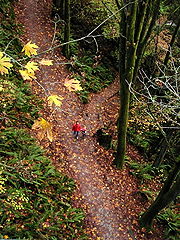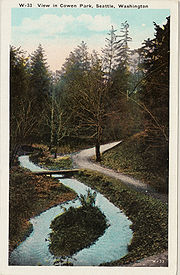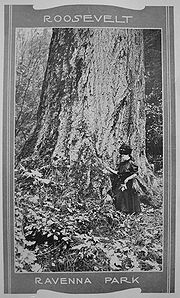
Ravenna Park (Seattle)
Encyclopedia

Ravenna, Seattle, Washington
Ravenna is a neighborhood in northeastern Seattle, Washington named after Ravenna, Italy. Though Ravenna is considered a residential neighborhood, it also is home to several businesses such as the University Village Shopping Center...
neighborhood of Seattle, Washington
Seattle, Washington
Seattle is the county seat of King County, Washington. With 608,660 residents as of the 2010 Census, Seattle is the largest city in the Northwestern United States. The Seattle metropolitan area of about 3.4 million inhabitants is the 15th largest metropolitan area in the country...
in the United States. These public parks encompass the ravine
Ravine
A ravine is a landform narrower than a canyon and is often the product of streamcutting erosion. Ravines are typically classified as larger in scale than gullies, although smaller than valleys. A ravine is generally a fluvial slope landform of relatively steep sides, on the order of twenty to...
with a maximum depth of 115 ft (35 m) through which Ravenna Creek
Ravenna Creek
Ravenna Creek is a stream in the Ravenna and Roosevelt neighborhoods of Seattle, Washington, whose present daylighted length of nearly 3500 feet is entirely within Cowen and Ravenna parks....
flows.
History

Strait of Juan de Fuca
The Strait of Juan de Fuca is a large body of water about long that is the Salish Sea outlet to the Pacific Ocean...
, but some features remained, including the Green Lake drainage basin
Green Lake (Seattle)
Green Lake is a freshwater lake in north central Seattle, Washington, USA, within Green Lake Park. The park is surrounded by the Green Lake neighborhood to the north and east, the Wallingford neighborhood to the south, the Phinney Ridge neighborhood to the west, and Woodland Park to the southwest...
, which continued to empty through the Ravenna ravine into Lake Washington
Lake Washington
Lake Washington is a large freshwater lake adjacent to the city of Seattle. It is the largest lake in King County and the second largest in the state of Washington, after Lake Chelan. It is bordered by the cities of Seattle on the west, Bellevue and Kirkland on the east, Renton on the south and...
. The deeper pockets of the basin became Bitter Lake
Bitter Lake
Bitter Lake can refer to a number of things:*Bitter Lake is the name of a lake in the state of New Mexico, near Roswell*Bitter Lake National Wildlife Refuge surrounds Bitter Lake in New Mexico...
, Haller Lake and Green Lake
Green Lake (Seattle)
Green Lake is a freshwater lake in north central Seattle, Washington, USA, within Green Lake Park. The park is surrounded by the Green Lake neighborhood to the north and east, the Wallingford neighborhood to the south, the Phinney Ridge neighborhood to the west, and Woodland Park to the southwest...
. Many creeks and brooks and springs fed into Green Lake, whose outlet was on the east side of the route of Ravenna Boulevard, in a deepening ravine which became Cowen and Ravenna parks.
Ravenna Creek
Ravenna Creek
Ravenna Creek is a stream in the Ravenna and Roosevelt neighborhoods of Seattle, Washington, whose present daylighted length of nearly 3500 feet is entirely within Cowen and Ravenna parks....
's original source was from Green, Haller, and Bitter lakes, then the Cowen Park ravine west wall when the watershed was diverted to sewers (1908–1948). The water table is relatively shallow, held by the extensive layer of clays that underlay the metro region. The creek source is actually seeping from the original west wall of the ravine, even though the gulch has been partially filled at the southwest corner of Cowen Park.
In the mid-1960s, the Cowen Park ravine was largely filled using freeway construction spoils. The City of Seattle planned to use the ravine for staging a comprehensive stormwater drainage piping project in 1986, galvanizing the neighborhoods of the watershed to protect and restore the park. Since 1991, the park has seen major restoration by residents of neighborhoods in collaboration with the City.
Ravenna Park
Ravenna Park is a ½ mile wooded ravine which connects two picnic areas just north of the University District. Activities include hiking, jogging and picnics. The park also features a play area for children, a wading pool, ballfield, trails, and tennis courts.Description
Ravenna Park contains 49.9 acres (20.6 ha) and was purchased from developers in 1911. Cowen Park covers 8.4 acre (3.5 ha). The current source of Ravenna Creek is the west face of the ravine along Brooklyn Avenue NE and a small wetlandWetland
A wetland is an area of land whose soil is saturated with water either permanently or seasonally. Wetlands are categorised by their characteristic vegetation, which is adapted to these unique soil conditions....
in the northwest corner, at NE 62nd Street. In 2006, a section of Ravenna Creek through the southeastern end of the park was daylight
Daylighting (streams)
In urban design and urban planning, daylighting is the redirection of a stream into an above-ground channel. Typically, the goal is to restore a stream of water to a more natural state...
ed, having formerly flowed into a storm drain. The parks are crossed from north to south by the Cowen Park Bridge
Cowen Park Bridge
The Cowen Park Bridge is a reinforced concrete arch bridge that spans a ravine in Seattle's Cowen Park. The structure is listed in the National Register of Historic Places, and it is a designated city landmark. The bridge has been praised for the Art Deco light standards along its sides.It was...
, on 15th Avenue Northeast on the boundary between the two parks, and the 20th Avenue Northeast Bridge (also known as the Ravenna Park Bridge), closed to motorized traffic since 1975. Both bridges are on the National Register of Historic Places
National Register of Historic Places
The National Register of Historic Places is the United States government's official list of districts, sites, buildings, structures, and objects deemed worthy of preservation...
. There is also a rail trail
Rail trail
A rail trail is the conversion of a disused railway easement into a multi-use path, typically for walking, cycling and sometimes horse riding. The characteristics of former tracks—flat, long, frequently running through historical areas—are appealing for various development. The term sometimes also...
along the southern edge of the park where David Denny
David Denny
David Thomas Denny was a member of the Denny Party, who are generally collectively credited as the founders of Seattle, Washington, USA. Though he ultimately underwent bankruptcy, he was a significant contributor to the shape of the city...
's Ravenna streetcar line once ran.
Flora
The parks are mostly forested with native Bigleaf MapleBigleaf Maple
Acer macrophyllum is a large deciduous tree in the genus Acer.It can grow to be up to 35 m tall, but more commonly grows 15 m to 20 m tall. It is native to western North America, mostly near the Pacific coast, from southernmost Alaska to southern California...
, Coast Douglas-fir
Coast Douglas-fir
Pseudotsuga menziesii, known as Douglas-fir, Oregon Pine, or Douglas spruce, is an evergreen conifer species native to western North America. Its variety Pseudotsuga menziesii var. menziesii, also known as coast Douglas-fir grows in the coastal regions, from west-central British Columbia, Canada...
, Western Hemlock
Western Hemlock
Tsuga heterophylla. the Western Hemlock, is a species of hemlock native to the west coast of North America, with its northwestern limit on the Kenai Peninsula, Alaska, and its southeastern limit in northern Sonoma County, California.-Habitat:...
, and Western Redcedar
Thuja plicata
Thuja plicata, commonly called Western or pacific red cedar, giant or western arborvitae, giant cedar, or shinglewood, is a species of Thuja, an evergreen coniferous tree in the cypress family Cupressaceae native to western North America...
. Nonindigenous trees include Coast Redwood, Incense-cedar
Calocedrus decurrens
Calocedrus decurrens is a species of conifer native to western North America, with the bulk of the range in the United States, from central western Oregon through most of California and the extreme west of Nevada, and also a short distance into northwest Mexico in northern Baja California...
, and Western Larch
Western Larch
Western Larch is a species of larch native to the mountains of western North America, in Canada in southeastern British Columbia and southwestern Alberta, and in the United States in eastern Washington, eastern Oregon, northern Idaho and western Montana.It is a large deciduous coniferous tree...
.

Hedera helix
Hedera helix is a species of ivy native to most of Europe and western Asia. It is labeled as an invasive species in a number of areas where it has been introduced.-Description:...
and Himalayan Blackberry
Rubus armeniacus
Rubus armeniacus, Armenian Blackberry or Himalayan Blackberry, is a species of Rubus in the blackberry group Rubus subgenus Rubus series Discolores Focke. It is native to Armenia in southwest Asia, and widely naturalised elsewhere...
from the park and restore native vegetation.
General references
- Cowen-Ravenna Park Trail Map, Seattle Parks and Recreation.
- http://content.lib.washington.edu/cgi-bin/queryresults.exe?CISOROOT=%2Fayp&CISOROOT=%2Fboyd&CISOROOT=%2FboydBraas&CISOROOT=%2Fcivilworks&CISOROOT=%2Fcobb&CISOROOT=%2Fcurtis&CISOROOT=%2Fdearmassar&CISOROOT=%2Ffera&CISOROOT=%2Fhester&CISOROOT=%2Findocc&CISOROOT=%2Flaroche&CISOROOT=%2FlarocheAlbum&CISOROOT=%2Flee&CISOROOT=%2Fmenus&CISOROOT=%2Fhupy&CISOROOT=%2Fpioneerlife&CISOROOT=%2Fptec&CISOROOT=%2Fpeiser&CISOROOT=%2Fportraits&CISOROOT=%2Fprosch_seattle&CISOROOT=%2Fprosch_washington&CISOROOT=%2Fseattle&CISOROOT=%2Fww-swps&CISOROOT=%2Fsocial&CISOROOT=%2Ftodd&CISOROOT=%2Fprotests&CISOROOT=%2Fwarner&CISOROOT=%2Fwto&CISOFIELD3=CISOSEARCHALL&CISOOP3=any&CISOBOX3=ravenna&CISOMODE=thumb&CISOSTART=31Historic photographs of Cowen and Ravenna Park from the University of Washington Libraries Digital Collections]
- Maps and modern photographs of the Ravenna Streetcar route
- High-resolution aerial image (Windows Live LocalWindows Live LocalBing Maps is a web mapping service provided as a part of Microsoft's Bing suite of search engines and powered by the Bing Maps for Enterprise framework....
)

